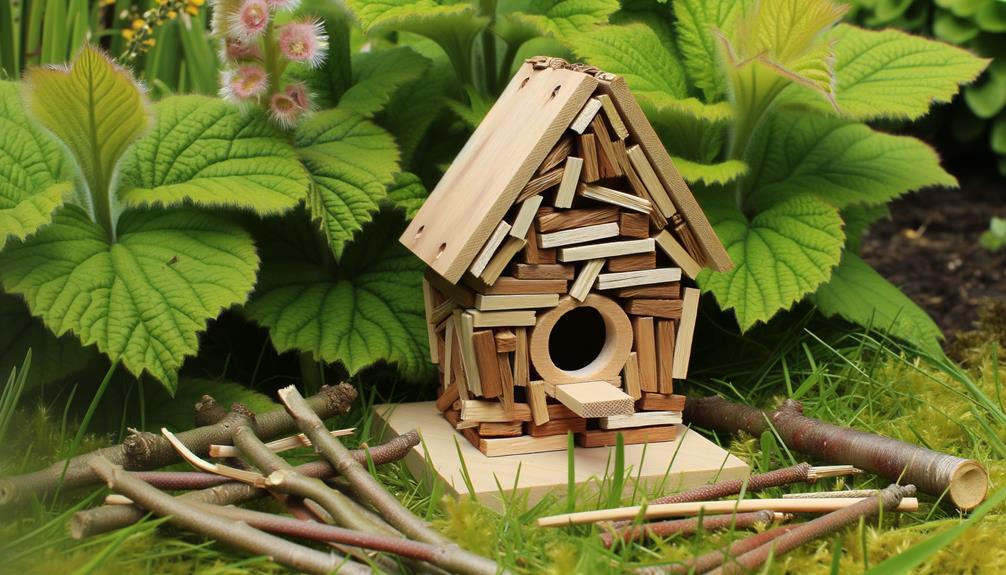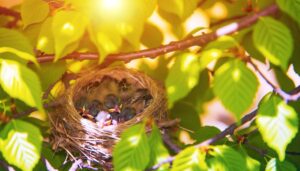Is Your Birdhouse Too Small for Baby Sparrows?
Yes, a birdhouse can be too small for baby sparrows. If it's cramped, it restricts their movement and hampers development.
A minimum internal floor space of 4×4 inches and a height of 6-8 inches is essential. Proper ventilation and drainage are essential to prevent health issues.
If the house is too small, it can lead to overcrowding, higher disease risks, and aggression among chicks. Ensuring adequate space allows for proper nest building and chick activity, promoting their health and growth.
If you're interested, you can learn more about the importance of birdhouse placement and materials.

Key Takeaways
- Small birdhouses restrict baby sparrows' movement, impairing their physical and behavioral development.
- Limited space in birdhouses can heighten aggression and increase disease transmission among chicks.
- Insufficient internal dimensions hinder proper nest building and chick activity.
- Overcrowded conditions in small birdhouses lead to stress and vulnerability to diseases.
- A birdhouse floor space of at least 4×4 inches and height of 6-8 inches is essential for healthy growth.
Importance of Proper Sizing

Ensuring the birdhouse is the correct size is essential for the survival and development of baby sparrows, as it directly impacts their safety and growth. You must pay attention to dimensions; a birdhouse that's too small can restrict the movement and expansion of the chicks, potentially stunting their development.
Aim for an internal floor space of at least 4×4 inches and a height of 6-8 inches. This guarantees adequate room for nest building and chick activity. Additionally, proper ventilation and drainage are crucial; they prevent overheating and moisture buildup, which can lead to health issues.
Sparrow Nesting Habits
Sparrows exhibit fascinating nesting habits, often favoring cavities in trees or man-made structures where they meticulously construct their nests using grass, feathers, and other soft materials.
You'll notice they prefer small, enclosed spaces that offer protection from predators and environmental elements. Sparrows are highly adaptable, choosing locations that ensure the safety and warmth of their young.
They're diligent in gathering materials, creating a soft, insulated environment for their eggs and hatchlings. Understanding these habits helps you create ideal nesting conditions.
Standard Birdhouse Dimensions

When designing a birdhouse for baby sparrows, you should prioritize the best entrance hole size and the interior space requirements.
The entrance hole should typically measure around 1 1/4 inches in diameter to keep out larger predators while allowing easy access for sparrows.
Additionally, make sure the interior space is spacious enough, around 4×4 inches, to accommodate the growing chicks comfortably.
Optimal Entrance Hole Size
An ideal entrance hole size of 1.25 inches in diameter is crucial for accommodating baby sparrows while deterring larger, competing bird species. When you provide this precise measurement, you create a sanctuary that supports the growth and safety of your feathered friends.
Larger species can't enter, reducing the risk of nest usurpation and predation. Additionally, this entrance size ensures that adult sparrows can access the nest comfortably without exposing the interior to excessive weather conditions.
You should measure the diameter accurately and regularly check for wear or damage to maintain ideal conditions. By focusing on this specific detail, you're directly contributing to the wellbeing and successful rearing of baby sparrows in your birdhouse.
Interior Space Requirements
Guaranteeing the interior space of your birdhouse meets the specific dimensions required for baby sparrows is crucial for their development and comfort. You should provide an interior floor space of at least 4 inches by 4 inches. This dimension allows enough room for the nest, the parent birds, and the growing chicks.
The height of the birdhouse should be around 6 to 8 inches to accommodate the vertical space needed for the nest and to guarantee adequate ventilation. Proper ventilation prevents overheating and keeps humidity levels stable, which is essential for the chicks' health.
Risks of Small Birdhouses
Inadequately sized birdhouses can lead to overcrowding, which increases the risk of disease transmission and stress among baby sparrows. When sparrows are confined to a small space, their immune systems can become compromised, making them more susceptible to pathogens.
Additionally, stress levels rise due to limited movement and competition for resources.
Consider these risks:
- Higher Disease Rates: Overcrowded conditions facilitate the spread of parasites and infectious diseases.
- Increased Aggression: Limited space can lead to heightened aggression, causing physical harm to the chicks.
- Developmental Issues: Restricted environments can impair physical and behavioral development.
Ventilation and Space Needs

Proper aeration and ample space are crucial for maintaining a healthy habitat in birdhouses for baby sparrows. You need to make sure that the birdhouse has small air vents near the top to allow for proper airflow, which helps regulate temperature and prevents moisture buildup.
Sparrows require enough room to move and grow, so the interior dimensions should be roomy enough to accommodate their development. Crowded conditions can lead to stress and increased vulnerability to disease. Additionally, consider the materials used; breathable, non-toxic wood is ideal.
Monitoring Sparrow Growth
To maximize sparrow development, you should track their daily growth and measure the nest space regularly. This will help you identify any signs of overcrowding, which can impact their health.
Accurate monitoring allows for timely adjustments to the birdhouse size, promoting healthier living conditions.
Daily Growth Tracking
Throughout each day, meticulously track the sparrows' growth by measuring their weight, beak length, and feather development to guarantee they're thriving in the birdhouse. Regular monitoring ensures early detection of any growth issues and helps you make informed decisions.
- Weight: Weigh each sparrow daily with a precision scale. Consistent weight gain signifies good health.
- Beak Length: Measure the beak with a caliper. A gradual increase indicates proper nutrition and development.
- Feather Development: Examine feather quality and emergence stages. Healthy feathers reflect adequate diet and living conditions.
Measuring Nest Space
In addition to monitoring individual growth metrics, it's important to measure the nest space to confirm baby sparrows have adequate room for healthy development.
First, use a small ruler or caliper to measure the length, width, and height of the nest cavity. Record these dimensions and compare them to recommended standards for sparrow nests, which typically require at least 4 inches in diameter and 6 inches in depth.
Verify the nest isn't constricting as the sparrows grow. Document changes to observe if the space becomes limiting over time.
Identifying Overcrowding Signs
Carefully monitoring sparrow growth metrics and nest occupancy levels can provide early indicators of overcrowding, ensuring their habitat remains conducive to healthy development.
To identify overcrowding, observe the following signs:
- Stunted Growth: If nestlings aren't growing at a typical rate, it may indicate insufficient space, leading to limited access to food and warmth.
- Feather Damage: Overcrowded nests can cause physical harm, such as bent or broken feathers, due to constant friction and lack of movement space.
- Behavioral Changes: Increased aggression or competition among nestlings for resources often signals overcrowding.
Materials for Building Birdhouses

When selecting materials for building birdhouses, prioritize untreated wood to safeguard a safe and non-toxic environment for baby sparrows. Untreated wood, like cedar or pine, ensures that harmful chemicals won't leach into the nesting area.
Avoid pressure-treated wood and plywood, as they can release toxins detrimental to sparrow health. Use corrosion-resistant screws and nails to enhance durability and prevent injuries.
Incorporate ventilation holes for adequate air circulation, reducing the risk of mold and overheating. The interior should remain smooth to prevent splinters, while the exterior may have a slight roughness to facilitate fledgling grip.
A sloped roof will effectively channel rainwater away, maintaining a dry, stable habitat. Your thoughtful material choice directly impacts the wellbeing of the little sparrows.
Placement of Birdhouses
After selecting the right materials, you'll need to think about the best placement of birdhouses for a safe and inviting environment for baby sparrows.
To optimize placement, consider these factors:
- Height: Mount the birdhouse at least 6-10 feet above ground. This elevation deters predators and provides a vantage point for sparrow parents.
- Orientation: Position the entrance hole facing away from prevailing winds. This aids in maintaining a stable internal temperature and keeps the nest dry.
- Proximity to Food and Water: Place the birdhouse near natural food sources and water. Proximity to these essentials can reduce the energy expenditure of parent sparrows, ensuring they can focus on caring for their young.
Careful placement significantly enhances the survival chances of baby sparrows.
Seasonal Adjustments

Adjusting your birdhouse setup seasonally guarantees that baby sparrows thrive year-round by adapting to changes in temperature, humidity, and food availability. In winter, insulate the birdhouse with straw or wood shavings to retain heat. During spring, ensure proper ventilation to prevent overheating as temperatures rise. Summer requires additional shade or relocating the birdhouse to a cooler spot. In autumn, clean the birdhouse thoroughly to remove parasites and prepare for new inhabitants.
| Season | Adjustment |
|---|---|
| Winter | Add insulation (straw, wood shavings) |
| Spring | Ensure ventilation |
| Summer | Provide shade or relocate |
| Autumn | Clean thoroughly for parasites |
Signs of a Happy Nest
Observing the behavior and condition of sparrows within the birdhouse can provide clear indicators of a thriving nest. Pay attention to these signs to guarantee the nest is a happy one:
- Feeding Frequency: Parents frequently enter and exit the birdhouse, indicating they're delivering ample food to their chicks.
- Chick Vocalizations: You hear consistent, energetic chirping from the chicks, suggesting they're healthy and active.
- Nest Cleanliness: The interior remains relatively clean, with minimal waste build-up, as parents efficiently remove droppings.
Each of these signs highlights a well-maintained environment and attentive parenting. By monitoring these indicators, you can guarantee that the birdhouse meets the sparrows' needs and supports their development.
Providing a suitable habitat directly contributes to the welfare of these delightful birds.
Conclusion
You've got the lowdown on creating a perfect birdhouse for baby sparrows.
Remember, size matters—too small, and it's like squeezing into a sardine can.
Proper ventilation and space are essential for their growth.
Use durable materials and place the birdhouse thoughtfully.
Keep an eye on seasonal changes and signs of a happy nest.
By following these guidelines, you'll guarantee the little chirpers are safe and sound, thriving in their new home.





